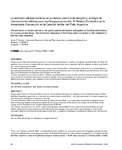La admisión del arte moderno en un templo patrimonial neogótico, anticipo de intervenciones edilicias para una liturgia posconciliar: el Retablo Eucarístico de la Inmaculada Concepción en la Catedral de Mar del Plata, Argentina

View/
Use this link to cite
http://hdl.handle.net/2183/26300
Except where otherwise noted, this item's license is described as Atribución-NoComercial-CompartirIgual 4.0 España
Collections
Metadata
Show full item recordTitle
La admisión del arte moderno en un templo patrimonial neogótico, anticipo de intervenciones edilicias para una liturgia posconciliar: el Retablo Eucarístico de la Inmaculada Concepción en la Catedral de Mar del Plata, ArgentinaAlternative Title(s)
The Admission of Modern Art into a Neo-Gothic Patrimonial Temple, Anticipation of Building Interventions for a Post-Conciliar Liturgy: the Eucharistic Altarpiece of the Immaculate Conception in the Cathedral of Mar del Plata, ArgentinaAuthor(s)
Date
2020Citation
Benítez, Analía E. 2020. «La admisión del arte moderno en un templo patrimonial neogótico, anticipo de intervenciones edilicias para una liturgia posconciliar. El Retablo Eucarístico de la Inmaculada Concepción en la Catedral de Mar del Plata, Argentina». Actas de Arquitectura Religiosa Contemporánea 7: 88-99. https://doi.org/10.17979/aarc.2020.7.0.6293.
Abstract
[Resumen]
Escasos años antes del Concilio Vaticano II, el incendio accidental de un retablo en la iglesia catedral de Mar del Plata (Argentina),
dio pie a que se irguiera allí una nueva y provocativa obra, única expresión del arte religioso moderno que habría
por mucho tiempo en la ciudad.
El nuevo retablo (1961) fue encargado por el obispo mons. Enrique Rau —personalidad destacada en la música litúrgica—,
que participó activamente en todas las sesiones del CVII como miembro de la Comisión Mundial para la Reforma de la Liturgia
y como Presidente del Departamento Litúrgico del CELAM.
La obra, emergida de un contexto artístico, cultural y espiritual distinto al que imperó cuando la catedral neogótica se construyó,
resalta en su ámbito expresando cambios ocurridos en forma y lenguaje, en vistas a la renovación que comenzaría la
Iglesia local poco después, para adaptarse a las modificaciones litúrgicas surgidas del Concilio. [Abstract]
Scarce years before the Second Vatican Council, the accidental burning of an altarpiece in the Cathedral Church of Mar
del Plata (Argentina), gave rise to a new and provocative work erected there —the only expression of modern religious art
that would have existed for a long time in the city.
The new altarpiece (1961) was commissioned by Bishop Enrique Rau —an outstanding personality in liturgical music—
who actively participated in all sessions of the Vatican II, as a member of the World Commission for the Reform of the
Liturgy and as President of the Liturgical Department of CELAM.
The artwork, emerged from an artistic, cultural and spiritual context different from that which prevailed when the Neo-
Gothic cathedral was built, stands out in its field expressing changes occurred in form and language, in view of the
renovation that the local Church would begin shortly after, to adapt to the liturgical modifications arising from the Council.
Keywords
Mar del Plata
Modernidad
Arte
Retablo
Renovación litúrgica
Modernity
Art
Altarpiece
Liturgical renewal
Modernidad
Arte
Retablo
Renovación litúrgica
Modernity
Art
Altarpiece
Liturgical renewal
Editor version
Rights
Atribución-NoComercial-CompartirIgual 4.0 España
ISSN
2659-8671






